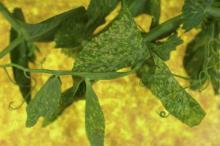Cause The pea enation mosaic virus. At least 8 species of aphid can transmit the virus but the principal vector is the pea aphid, Acyrthosiphon pisum. After the aphid acquires the virus, it is 8 or more hours before it can transmit it to a pea plant, but the aphid retains the ability to transmit the virus for at least 24 hours, during which time it can fly or be blown long distances.
Plant hosts include chickpea, lentil, faba bean, broadbean, sweet pea, certain species of lupine; Hungarian, common, and hairy vetch; and several species of clover including Alsike, white, crimson, and subterranean. Weedy subterranean clover is the principal overwintering host in western Oregon. Alfalfa is not a host. This virus can be detected in seed but is not transmitted by seed.
Symptoms Mottling, crinkling, and stunting followed by tissue outgrowths on leaves and pods. Pods may be badly distorted.
Cultural control
- Using resistant varieties is the only satisfactory control. Since the variety, Perfected Freezer 60, was developed, many good commercial varieties have become available. The following are enation mosaic-resistant varieties:
- Edible pod- Green Sugar, Oregon Sugar Pod.
- Canners- Prospector, Corvallis.
- Freezers- Citation, Almoto, Freezer 50, Aspen, Mohawk, Aurora, Perfected Freezer 60, Trident, Knight.
- If using susceptible varieties, planting before March 31 helps avoid aphid infestation. Controlling aphids helps in years when they are relatively few.
References Larsen R., Timmerman-Vaughan, G., and Murray, S. 2007. Molecular evidence that pea enation mosaic virus is seedborne but not seed transmitted in Pisum sativum. Phytopathology 97:S62.
Timmerman-Vaughan, G., Larsen, R., Murray, S., McPhee, K., and Coyne, C. 2009. Analysis of the accumulation of pea enation mosaic virus genomes in seed tissues and lack of evidence for seed transmission in pea (Pisum sativum). Phytopathology 99:1281-1288.


